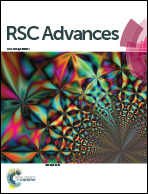Sepiolite/CNT/S@PANI composite with stable network structure for high performance lithium sulfur batteries†
Abstract
Composite materials with a stable network structure consisting of natural sepiolite (Sep) powders, carbon nanotubes (CNTs) and conductive polymer (PANI) have been successfully synthesized using a simple vacuum heat treatment and chemical oxidation method, and they have been used as cathode materials for lithium sulfur batteries. It is found that Sep/CNT/S@PANI composites possess high initial discharge capacity, good cyclic stability and good rate performance. The initial discharge capacity of the Sep/CNT/S@PANI-II composite is about 1100 mA h g−1 at 2C, and remained at 650 mA h g−1 after 300 cycles, and the corresponding coulombic efficiency is above 93%. Such performance is attributed to specific porous structure, outstanding adsorption characteristics, and excellent ion exchange capability of sepiolite, as well as excellent conductivity of CNT. Furthermore, the PANI coating has a pinning effect for sulfur, which enhances the utilization of the active mass and improves the cycling stability and the coulombic efficiency of the composites at high current rates.



 Please wait while we load your content...
Please wait while we load your content...